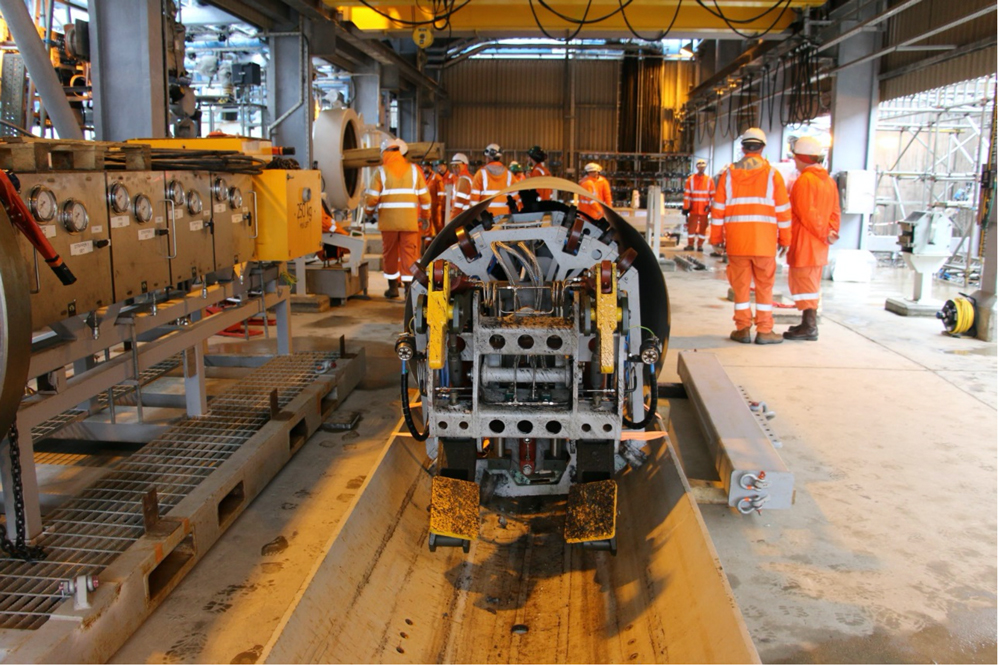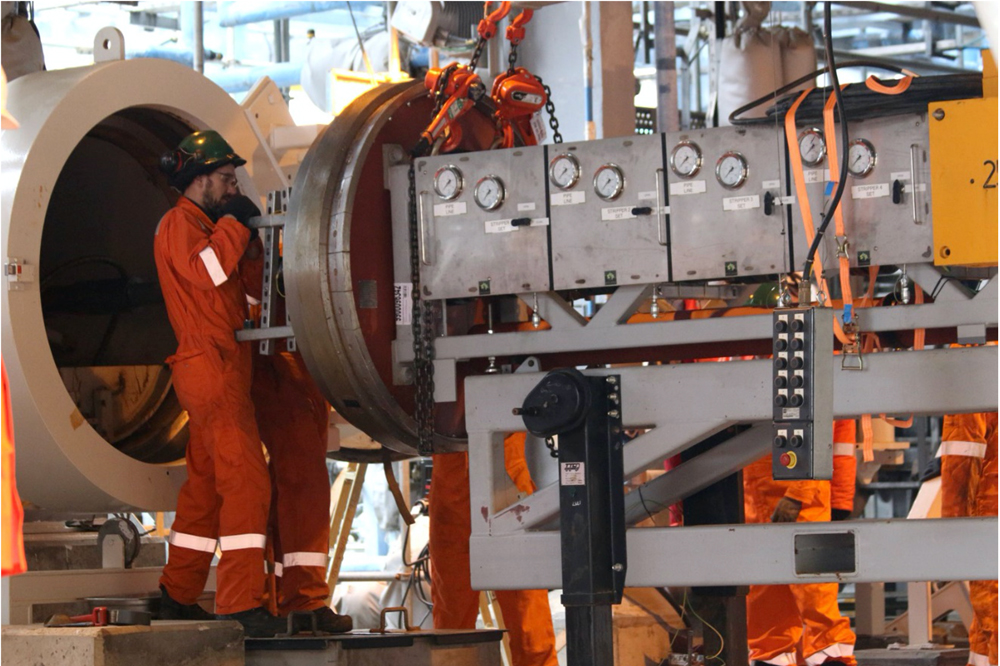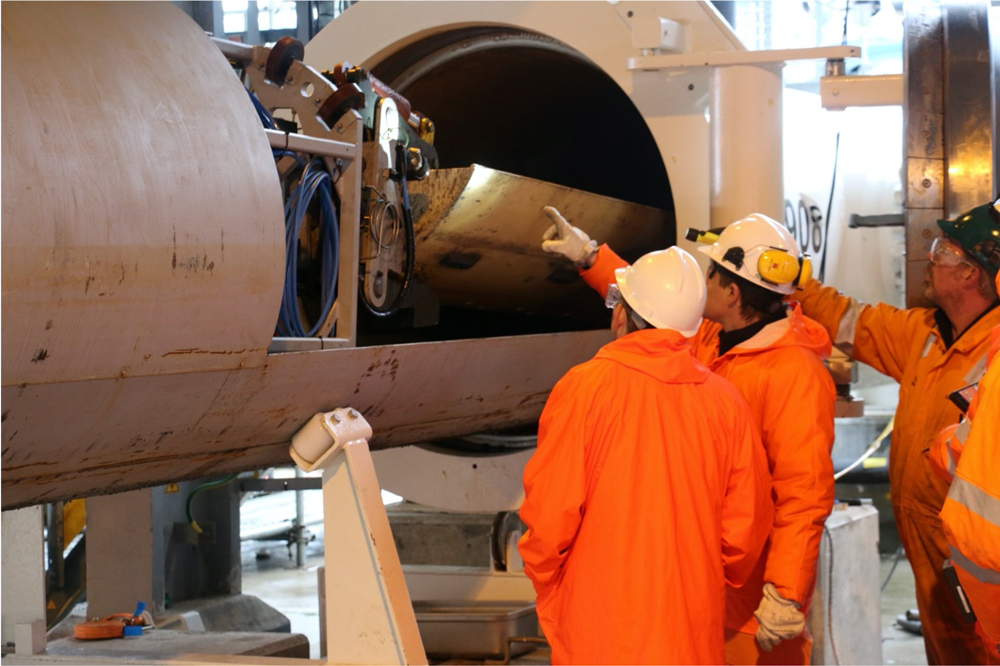April 2023, Vol. 250, No. 4
Features
Pig Removal: Recovering an Obstruction in Pressurized 48-Inch Pipeline
Special to Pipeline & Gas Journal
(P&GJ) —Following the completion of an offshore pipeline isolation project, STATS were asked by the client if they could offer a solution to a problem of an obstruction in their 48-inch gas export pipeline.
During routine launching of an inline inspection tool, a slipper tray was accidently carried into the pipeline and lodged in the first pipeline bend, above grade, about 39 meters from the launcher door.
The slipper tray is a fabricated item, about 7-meters-long and weighing 1.3 tons. It is used as an aid for loading pigs and pipeline inspection tools into the pig launcher. Although the slipper tray was not affecting pipeline production, its removal was essential to allow for a scheduled pipeline inspection run and a future plant expansion project.
STATS Group was initially contracted to conduct an engineering feasibility study for removal of the lodged slipper tray. On completion, a custom tool was proposed with a deployment and recovery system, onboard camera system and most importantly, a temporary launcher door and stuffing box arrangement to act as a temporary pipeline pressure boundary.
The design specification required that all equipment be to be fully rated for a 100-bar live operation. The system design was essentially an amalgamation of existing STATS equipment and technologies except the Grabber Tool, which was a bespoke design for the scope.
The Slipper Tray Recovery System was designed to be deployed into the pipeline, advanced through the launcher, past the two launcher valves, barred tee and ESDV and secure the slipper tray. Once latched onto the slipper tray, the tool and tray would then be recovered back to the pig launcher, through the valves and into the launcher.
The valves would then be closed, sealed and the launcher vented and purged as per normal plant operating procedures and the slipper tray removed. An additional challenge was that there was a limited operational window to complete the recovery due to parallel planned shutdown site activities.
A technical risk assessment of the concept with the client led to the identification of a number of risks that could be “engineered out.” This involved the inclusion of a hydraulic release and an overpull break out of the stem bars from the tool in the event that the tray could not be dislodged from its current position, a hydraulic system failure or the grabber tool manipulators were locked onto the slipper tray.
The reasoning behind this was that although the operation would not be successful, ESDV functionality would still be available for continued pipeline operation if disconnection was possible.
A revision of the concept design to include the features highlighted from the technical risk assessment allowed the client to submit the Grabber Tool to their Options Select Committee for recovery of the slipper tray. In total, the client had seven options to review.
With the equipment and STATS team on site, the work began. The first site activities were unpacking, inspection, assembly and testing of the equipment in a non-zoned area. With the pre-deployment checks completed, the equipment was transferred to the pigging station on the plant. Modifications to the launcher area in the pigging station, identified during site survey, were required to allow assembly of the equipment.
With the site pre-works completed, the launcher isolation valves, which were known to pass, were injected with sealant to allow integrity testing of the launcher prior to opening. The pig launcher was then purged with nitrogen to reduce the hydrocarbon content to an acceptable level to allow the door to be opened and the Grabber Tool to be loaded.
The tool was hydraulically operated from a habitat situated in line of sight of the launcher and stem bar assembly operations. As the tool operated inside the pipeline, hydraulic functionality was controlled by the operator outside of the pipeline.
To allow for this functionality, a modified 52-inch launcher door was specified, original equipment manufacturer (OEM) supplied with the addition of two through ports, one to accommodate the stem bars and another to accommodate the camera system electrical porting.
At client request, the modified door was analysed by the OEM to confirm it was still within design code allowable stress for the operation, which was confirmed by the manufacturer.
With the launcher door opened and secured out of the way of the operations, the tool complete with deployment sleeve, wheel centralisers and stem bars were loaded into the launcher and the temporary door fitted and secured.
The launcher, complete with new temporary door and tool assembly was then pressure tested with nitrogen to verify the integrity of the new door seal and the stuffing boxes.
The launcher pressure was then equalized to pipeline pressure to ensure no differential across the two launcher valves. With the pressure equalized, the launcher valves were opened to allow passage into the pipeline.
To deploy the tool, a system of stem bars running through the hydraulic stuffing boxes was used. The stem bars are tubulars with sealing bulkhead threaded connections which carry the individual hydraulic hoses, which were colour coded and individually keyed quick connections to prevent any crossed hydraulic circuits.
The early stage project technical risk assessment identified a buckled or ruptured stem bar as a potential leak path to atmosphere that could not be stemmed, this risk drove the dual seal bulkhead stem bar design which would only allow a single stem bar to suffer hydrocarbon ingress in the unlikely event of a rupture or buckle and a vent tee between the stuffing boxes would allow a single gas filled stem bar to be vented safely before being recovered to atmosphere. Twelve stem bars were required for the operation.
To provide a pressure competent boundary to the pipeline during the operation, a system of four stuffing boxes was specified, arranged in two pairs with a vent tee arrangement between each pair to allow any fugitive emissions to be safely managed and vented to a safe area. The stuffing boxes operate by application of hydraulic pressure to deform an elastomeric seal onto the stem bar.
Typically, the stuffing boxes require a hydraulic pressure 10 bar greater than pipeline pressure to achieve an effective seal in both static and dynamic operation. During the recovery operation, two stuffing boxes were in use with two available as contingency back-ups.
The annular voids between each stuffing box had a double block and bleed valve arrangement complete with a gauge allowing the technicians to identify if any hydrocarbon bypass had taken place. This was a key safety feature to ensure no hydrocarbon escape to atmosphere.
To advance the tool into the pipeline and to overcome the ejection force from the pressure of the pipeline, a hydraulic deployment system was developed by STATS. A long stroke, double acting hydraulic cylinder was mounted in the deployment system that could push and pull each stem bar through the launcher door to advance or retract the tool.
Once each of the stem bars was deployed to a pre-determined point, they were locked in place whilst the next stem bar was loaded, allowing the hydraulic quick connects to be made-up and the lines pressure tested. Each new threaded connection was externally pressure tested to verify joint integrity prior to deployment into the pipeline.
When the tool was within range of the slipper tray, control was transferred to a separate, fine control hydraulic console to manipulate the head for final alignment and engagement with the slipper tray. The Grabber Tool is controlled hydraulically, with the head able to lift/lower, rotate and open or close the grabber as required.
Manoeuvrability was a key design requirement for the tool to allow for final alignment adjustments once the Slipper Tray was in view. Four pressure competent cameras were fitted, three on the tool itself, configured as two forward facing and one rear facing with the fourth camera mounted on the temporary launcher door.
The forward-facing pair were focussed on the tray to allow visual confirmation for the grab operation, the rear facing camera was used to confirm no stem bar buckling had occurred.
With the Slipper Tray in range, the operators activated the hydraulic circuits to extend and engage the tool onto the slipper tray and lock in place to ensure grip was maintained throughout the recovery process.
During the operation the equipment inside the pipeline was straddling the ESDV and in the event of a plant shutdown there was a risk that the ESDV could close on the stem bars or tool in the bore. The risk to the operation and potential damage to the ESDV itself was mitigated by inhibiting the ESDV function during the recovery operation.
The tray recovery was a reversal of the deployment operation, with the stem bars hydraulically extracted and disconnected. Once the tool with the Slipper Tray was confirmed as fully retracted into the pig launcher, confirmed by both physical measurement and video image from inside the pipeline, the launcher valves were manually closed as a safety precaution over using the motorized actuators.
The launcher valves were re-sealed, and the launcher was vented and purged in accordance with normal operating procedures prior to opening. The deployment/recovery system was dismantled and removed and the pig handling equipment that was removed as part of the operational pre-works was reinstalled.
The temporary launcher door and stuffing boxes were removed, and the tool and slipper tray were recovered. The launcher door was closed concluding a successful recovery operation of the Slipper Tray and the pipeline was handed back to the client.









Comments